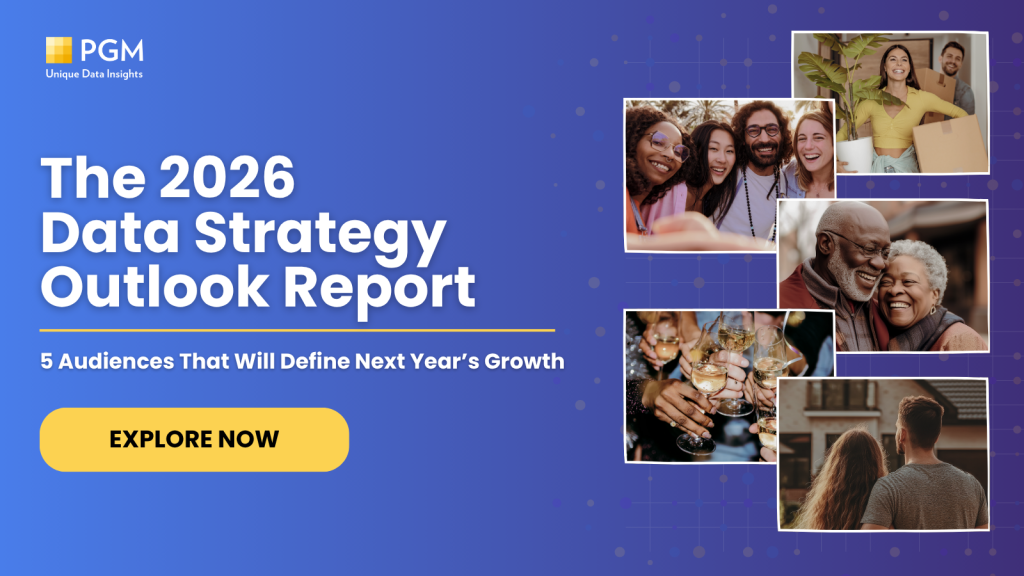As a marketer, I love a good list of statistics, and even better when they are accompanied by a good chart.
If you’ve stumbled on this article, you probably are just as keen to read up on the latest email marketing statistics.
Our team curated the latest stats we could find to help you stay current and informed for 2026.
Table of Contents
- Email Usage
- Email ROI
- Email Personalization
- Email Subject Lines
- Mobile Email
- Email Frequency and Timing
- Just for Fun
Email Usage Statistics for 2026
Did you know that the first email was sent in 1971? It was sent by Ray Tomlinson to himself. “The test messages were entirely forgettable. Most likely the first message was QWERTYIOP or something similar,” he said. Since then, email has grown into the vibrant channel we know today. Take a look at these stats on how it has grown and who is using email.
- The number of global e-mail users is set to grow to 4.73 billion users in 2026.
- The number of emails sent every second exceeds 3.13 million.
- Gmail is the most popular email provider, with 1.8 billion active user accounts worldwide.
- The average user has at least 1.86 email accounts.
- An estimated 376.4 billion emails are sent and received daily worldwide.
- The average person receives between 100 to 120 emails per day.
- 99% of email users check their email every day, some as much as 20 times a day.
- Consumers spend an average of 10 seconds reading brand emails.
- Checking email is the first thing people do online; 58% of users check their email before they check out social media or the news.
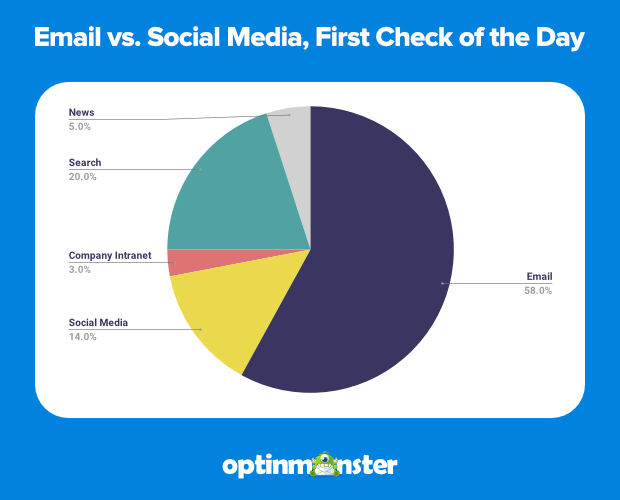
- Checking email is also a complementary activity. People do it while watching TV (69%), in bed (57%), and on vacation (79%).
- 89.45% of Americans over the age of 15 use email. Ninety percent of users aged 15 to 24 use email, as do 93.6% of those aged 25 to 44. At age 45 to 64, usage drops back to 90% (still by far the vast majority of U.S. adults), and at over 65, the email use rate is 84.1%.
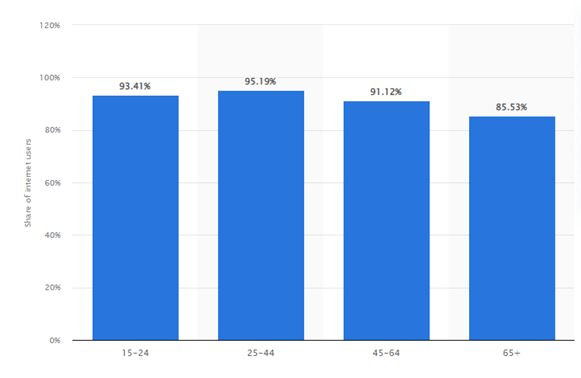
- 99% of email users check their inbox every day, with some checking 20 times a day. Of those people, 58% of consumers check their email first thing in the morning.
- 40% of consumers say they have at least 50 unread emails in their inbox.
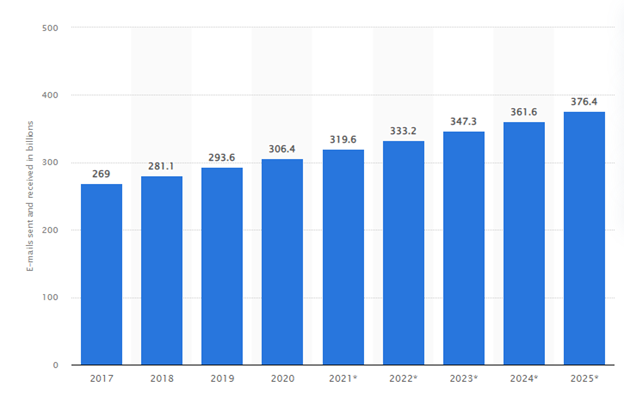
- The latest email users statistics for the US show that 90% of people older than 15 use email. The highest email usage by age group is within the 25-44 range with 93.6%. The penetration rate is 90% or higher for 15-24 and 45-64 as well. The only age group with less (84.1%) is over 65. (Statista)
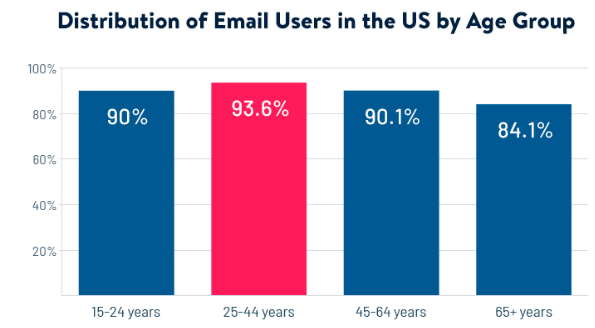
- 99% of consumers check their email every day.
- 58% of consumers open their email first thing in the morning.
- As many as 20.41% emails are opened within the first hour of delivery.
- 59% of millennials primarily use their smartphone to check email, while 67% of Gen Z scans their inbox on mobile.
- 74% of baby boomers think email is the most personal channel to receive communications from brands, followed by 72% of Gen X, 64% of Millennials, and 60% of Gen Z.
- 91% of women in the US use email, compared to 89% of men.
- People aged 35 and older spend an average of 5 hours per day using email.
Email ROI Statistics for 2026
One of the reasons email is so popular is because of the incredible ROI it brings in. A relatively simple channel to implement, email brings the biggest bang for the buck compared to almost every other channel. Take a look at these statistics showing just how effective email is.
- The average expected ROI is $42 for every $1 you spend on email marketing.
- According to Omnisend, the average ROI is $40 for every $1 of spend.
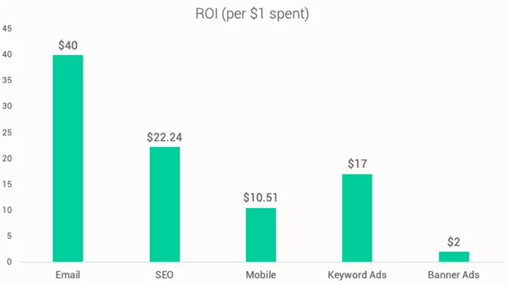
- Constant Contact reports that for every $1 a company spends on email marketing, they can expect to earn $38 of revenue on average.
- 18% of companies achieve email marketing ROI greater than $70 per $1 invested.
- A survey from eMarketer reveals that email marketing drives 25% of the overall revenues from those companies surveyed.
- The median email marketing ROI is 122% – four times higher than any other digital marketing channel.
- Consumers who purchase products through email spend 138% more than those that don’t receive email offers.
- 89% of marketers use email as the primary channel for generating leads.
- Marketers listed email marketing as the most effective marketing strategy, followed by Paid Search/Ads, Organic Search, Social Media, and Events. 79% of marketers included email within their top three marketing channels.
- Email marketing persuades the purchasing decisions of nearly 6 out of every 10 email subscribers. At least once per month, 50.7% buy something from a marketing email. Meanwhile, 23.8% of people make a purchase via marketing emails several times per month and 3% do it more than once per week!
- Marketers who segment email lists increase email marketing revenue by 760%.
- Email marketing revenue is estimated to reach almost 11 billion by the end of 2023.
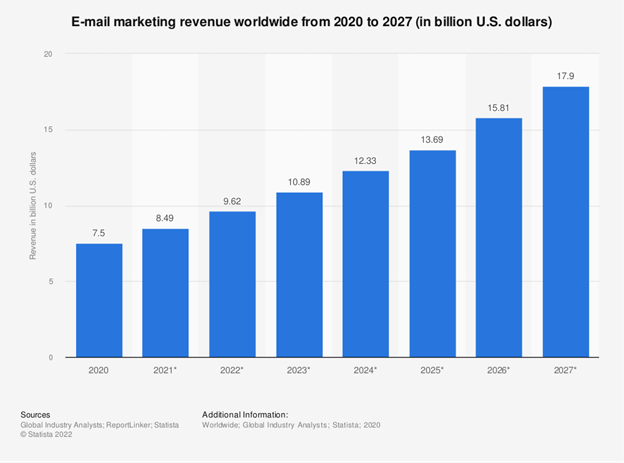
- Email is 40x more effective than social media for customer acquisition.
- 4.24% of email traffic leads to purchases, whereas only 2.49% of search traffic and 0.59% of social traffic does the same.
- In a Statista report, 73% of Company respondents and 75% of Agency respondents rated email marketing as an excellent digital marketing channel for ROI.
- The global value of email marketing continues to grow from $7.5 billion in 2020 to a potential $17.9 billion by 2027.
- Out of all marketers, 87% plan to invest more capital in their email marketing budget.
- A/B testing can increase your email marketing ROI by as much as 37%.
- 59% of respondents say marketing emails influence their purchase decisions and 80% of business professionals believe that email marketing increases customer retention.
- 43% of marketers are changing how they measure email performance because of Apple’s Mail Privacy Protection, and 24% aren’t making any changes for now.
- The most significant way that email marketers adapted to recent data privacy changes was by prioritizing different KPIs.
On-Demand Webinar: Expert Email Deliverability Hacks
Email Personalization Statistics for 2026
Consumers want personalized experiences and will favor businesses that provide those 1:1 experiences. In fact, 80% of consumers are more likely to buy from a company that provides a tailored experience. Creating a customized experience goes a long way in cutting through the clutter and boosting engagement.
- The most effective strategies for email marketing campaigns are subscriber segmentation (78%), message personalization (72%), and email automation campaigns (71%).
- Personalized emails are 6 times more likely to drive conversions.
- In one survey, 88% of respondents said they look more favorably on emails that feel personally written for them.
- Email is considered the most personal method of brand communication by 74% of Baby Boomers, 72% of Gen X, 64% of Millennials, and 60% of Gen Z Users.
- 74% of people hate being shown irrelevant content, which makes personalization incredibly important to a great email marketing strategy.
- 77% of marketers say they use email to send personalized content to their subscribers.
- Many marketers personalize emails based on their demographics like gender and age; 66% of marketers personalize their emails based on age data.
- Personalized emails deliver 6x higher transaction rates.
- Emails with personalized subject lines get a 26% boost in open rates.
Email Subject Line Statistics for 2026
An email subject line is the first impression a consumer has of your marketing message and you can either hook them or lose them depending on how well your email subject line is written. A catchy phrase, a compelling stat, a funny emoji – all are tricks of the trade. Take a look at these stats discussing the importance of a well-written subject line.
- The average number of email characters in a subject line is 43.85.
- The word “video” on the email subject line increases the open rate by 19% and the click-through rate by 65%. Plus, it decreases unsubscribes by 26%.
- Including videos in your email content can increase your click rates up to 300%.
- 47% of email recipients will open an email based on the subject line alone.
- 69% of email recipients will report spam based on the subject line.
- Urgent subject lines increase the open rate by an average of 22%.
- Emails with the recipient’s name in the subject line have an 18.30% open rate.
- Those that do not have names in the subject line only have a 15.70% open rate.
- Including the word “Free” in the subject line were 10% more successful in being opened.
- 50% – the increase in open rates of emails with personalized subject lines, another study shows.
- Interactive subject lines have 70% higher conversion rates.
- Discount-based offers in subject lines have a below-average performance at 38.31%.
- Emails with emojis in their subject lines have a 39% open rate on average.
- Emojis in subject lines increase the effectiveness of marketing by 70%.
- The most significant steps marketers take to champion accessibility when creating their emails is writing short, descriptive subject lines, making links and buttons easy to see, and keeping paragraphs short and simple.
Mobile Email Statistics for 2026
Your audience is mostly mobile – you should be too. This is no longer an option, but don’t take our word for it. Take a look at the statistics proving the importance of going mobile.
- Mobile clients account for 41.6% of email opens, followed by webmail opens at 40,6% and desktop opens at 16,2%.
- About 3 in 5 consumers check their email on the go (mobile) and 75% of say they use their smartphones most often to check email.
- 35% of business professionals view their emails on mobile devices.
- Mobile phones are used as emailing devices by 1.7 billion people.
- 42.3% of users delete emails that are not optimized for mobile devices.
- Mobile email views outrank desktop views by up to 3x.
- 85% of users access their inboxes on a mobile device.
- 36.3% of global email opens are done through mobiles. Despite this mobile marketing trend, 20% of marketing campaigns are not properly optimized for mobile.
- 75% of Gmail users read their emails on a smartphone or tablet.
- Apple’s email application is the most used platform for mobile emails.
- There’s a 65% higher chance that visitors will view your website after reading a mobile email.
- A majority of email views come from mobile devices (41%), followed by desktop (39%).
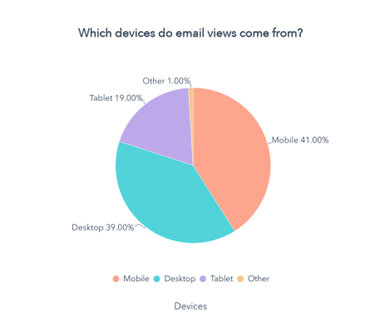
- Nearly 1 in 5 email campaigns is not optimized for mobile devices.
- Launching a mobile-responsive email design can increase unique mobile clicks by 15%.
- 56% of marketers leverage mobile-friendly emails in their email marketing strategy.
Email Frequency and Timing Statistics for 2026
Does timing really matter for sending emails? How many times a week should you send emails? You’ve created the perfect email, but finding the right frequency and timing is just as important. Here is what your fellow marketers have to say:
- 61% of subscribers/customers would like to receive promotional emails every week, 38% – more frequently.
- Marketers get in touch with their clients (per month): 2-3 times (32%), 4-6 times (19%), once (17%), 6+ times (16%).
- 28% of subscribers state they’d like to see promo offers twice or even thrice a week.
- 18% of emails are sent on Thursdays, 17% on Tuesdays, 16% on Wednesdays.
- The worst open and click-through rates are on weekends.
- 11 AM is the best time for sending emails, 12 PM shows the highest CTR.
- Traffic peak is in autumn and winter (especially on Black Friday, Cyber Monday and December 23).
- 50% of marketers claim that there is no perfect time for sending email campaigns as every person and business is unique.
- The best days for emails are Tuesday and Thursday.
Just For Fun Email Marketing Statistics for 2026
So, we have 90 stats now on why you should invest in email marketing. If I haven’t convinced you by now, then at least I can say I gave it the old college try, and it’s time to move onto something a bit more interesting. Check out these just-for-fun facts:
- In 1991, there was an email received from space sent by the crew of the STS-43 Atlantis. The message read: Hello Earth! Greetings from the STS-43 Crew. This is the first AppleLink from space. Having a GREAT time, wish you were here,…send cryo and RCS! Hasta la vista, baby,…we’ll be back!
- In 1978, the first SPAM email was sent. Gary Thurek earned the title “father of spam” after sending an unsolicited email marketing message to hundreds of ARPANET users, promoting a new product for Digital Equipment Corporation. Thurek claims the email earned $13 million in sales.
- In 1989, Elwood Edwards’ voice was used for the “You’ve Got Mail” notification. At the time, Edwards was working in broadcasting and his wife worked at AOL. She asked him to record a few lines, which he did on a cassette tape in his living room.
- In Season 14 of The Simpsons, Homer reveals his email address: chunkylover53@aol.com. This was set-up by Matt Selman, one of The Simpsons’ writers, who actually tried to answer all incoming messages as Homer, which proved to be impossible since he received hundreds and hundreds of them a day.
- For every 12,500,000 emails sent, spammers receive one reply. Which is one too many.
- Spam email sites earn senders around $7,000 per day.
- President Bill Clinton was the first US President to send an email while in office? He sent only two. He sent one as a test and the other he got a little help from White House staff. Clinton emailed astronaut John Glenn who was on the Space Shuttle in orbit.
- Bill Gates gets the most spam. He gets around four million spam emails every day!
- Email confidentiality – In 2000, the Pentagon accidentally included Claire McDonald, a schoolgirl in the United Kingdom on a top-secret email list. It took them four years, but they finally realized they had included her.
- The most popular password was “123456”, used by more than 10,000 Hotmail users.


